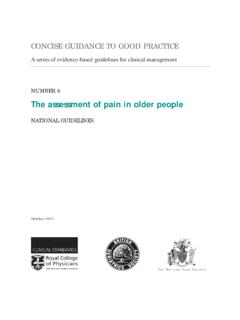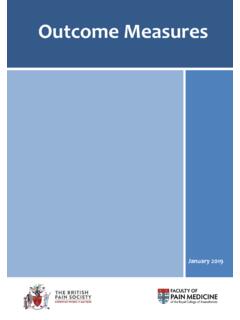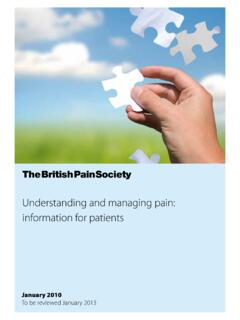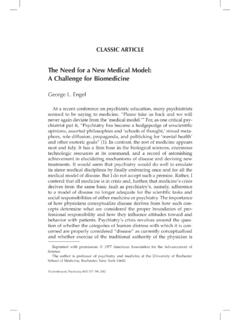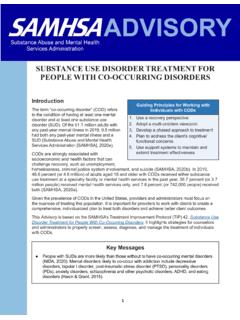Transcription of Guidelines for Pain Management Programmes for adults
1 Guidelines for pain Management Programmes for adultsAn evidence-based review prepared on behalf of the British pain Society The British pain SocietyNovember 2013To be reviewed October 20182 The British pain Society2 Published by: The British pain Society 3rd floor Churchill House 35 Red Lion Square London WC1R 4SG Website: ISBN: 978-0-9561386-4-4 The British pain Society 2013 Guidelines for pain Management Programmes for adults 3 Contents PageForeword 5 Definitions and approach to evidence 61. Executive summary 82. Background 103. PMPs: aims, methods, delivery and outcomes 124. Assisting retention and return to work in PMPs 195.
2 Referral and selection 226. Resources 257. References 31 Membership of the group and expert contributors 37 34 The British pain SocietyGuidelines for pain Management Programmes for adults 5 ForewordIn 1997, the pain Society (now the British pain Society) published Desirable Criteria for pain Management Programmes . This was a response to the perceived need for information and guidance for those involved in developing and running such biopsychosocial interventions. This third revision aims to provide updated guidance on what constitutes a pain Management programme (PMP), its position within care pathways for people with chronic (non-cancer) pain and desirable content.
3 A key evolution of the document is to apply current standards of evidence-based practice to the Guidelines by applying a rigorous, explicit approach. The document complements other British pain Society initiatives such as the Map of Medicine and pain Patients Pathway which helps to define care pathways as a whole. Within these pathways, biopsychosocial interventions are a pivotal functions of this document are: To provide a set of standards of care and Guidelines for provision of Programmes of rehabilitation to improve health outcomes. To provide healthcare professionals (HCPs) of various disciplines with a synthesis of current best practice.
4 To provide commissioners and provider organisations with an outline framework for effective and sustainable service provision. To update stakeholders on the scientific foundation of practice and quality issues relating to this treatment. An accompanying document Participant information for pain Management Programmes provides information specifically for people with chronic pain and document begins with a general background as well as evidence for PMPs. It considers its target group in section 2, while addressing the more specific aims as well as methods, delivery and outcomes in section 3. Strategies to enable return to work and retention at work are considered in section 4.
5 The challenge of selecting people appropriately while reaching as wider target group as possible is considered in section 5 and the resources required, including, staff, training and other essentials, in section 6. 56 The British pain SocietyDefinitions and approach to evidenceThe document uses the term chronic pain meaning persistent pain beyond the time that tissue healing would normally be expected taken as beyond 3 months. This is the most widely used and recognised term, although it is acknowledged that this is not the only term and there are sound arguments to justify the use of alternative terms such as long-term pain or persistent pain .
6 For simplicity, the document refers to PMPs as a treatment. It avoids the term patient, instead using the term participant or equivalent which is consistent with the ethos of demedicalisation. In addition, it uses the term interdisciplinary instead of multidisciplinary team. This most accurately reflects the way separate disciplines work together within a common model using cognitive behavioural principles. It is accepted that definitions and use of these terms can that formerly this document was a consensus statement, a thorough evaluation of the best evidence has been undertaken consistent with the best approaches available.
7 We have used the SIGN approach. The scheme for Level of evidence used (see below) is extracted from that document (see SIGN 50).The search strategy involved the use of standard databases ( Medline and Embase) as well as evidence-based resources. Each section was researched by a subgroup of the Working Group to provisionally agree evidence ratings. Evidence-based entries were then presented to the whole working group one by one. The entries were justified, debated and then, accepted, rejected or changed through this peer review. Final consistency checks were made and the document reviewed by the BPS Communications committee.
8 It was agreed in advance that the Working Group would attempt to reach a consensus through discussion of each item. A decision was made to avoid resolving opinion differences by any artificial means. Where significant differences of opinion arose, it was agreed to capture the debate, difficulty or range of opinion rather than resolve it. The participant information was reviewed by the Liverpool Smile User Group. TheThe production of the Guidelines will be followed by an implementation strategy developed through the pain Management Specialist Interest of evidence 1++ High-quality meta-analyses, systematic reviews of randomised controlled trials (RCTs) or RCTs with a very low risk of bias.
9 1+ Well-conducted meta-analyses, systematic reviews or RCTs with a low risk of bias. 1 Meta-analyses, systematic reviews or RCTs with a high risk of bias. 2++ High-quality systematic reviews of case control or cohort studies. High-quality case control or cohort studies with a very low risk of confounding or bias and a high probability that the relationship is causal. 2+ Well-conducted case control or cohort studies with a low risk of confounding or bias and a moderate probability that the relationship is causal. 2 Case control or cohort studies with a high risk of confounding or bias and a significant risk that the relationship is not causal.
10 3 Non-analytic studies, case reports, case series. 4 Expert opinion. Guidelines for pain Management Programmes for adults 7 Grades of recommendation Note: The grade of recommendation relates to the strength of the evidence on which the recommendation is based. It does not reflect the clinical importance of the recommendation. A At least one meta-analysis, systematic review or RCT rated as 1++, and directly applicable to the target population; or a body of evidence consisting principally of studies rated as 1+, directly applicable to the target population, and demonstrating overall consistency of results.

